Serbian Medieval History
Serbian History Through Coinage
By Radmilo Bozinovic -
From the advent of coinage more than 2,600 years ago, numismatics - the study of metal currency - has been a fascinating and rewarding endeavor. By studying the images represented, the language of inscriptions, artistic expression, metal composition, and more, we can often find valuable evidence not only for a particular monetary economy, but also about distant times and societies, and the dynamics of their development. We hope that the material presented will illustrate the power of numismatic research, but even more so the rich historical experience of the times it covers.
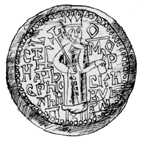 Medieval Serbian Coinage
Medieval Serbian Coinage
Despite serious research that has been continuously performed on the subject since the mid-19th century, Serbian medieval numismatics remains both rather obscure and inconclusive on many issues. There is no consensus, say, on the attributions (to rulers), mint dates, or interpretations of various symbols ("mint-marks") for a great many of the coin types, which adds a dose of mystery to the subject.
Although it existed for only about 200 years, medieval Serbian coinage shows a remarkable variety, with an estimated 600 types and variants - many of them borrowing from designs existing in other coinages, but also including some original ones. While many millions were minted overall, an estimated 50-60 thousand are in existence today (mostly in museums and a few bigger private collections), a large part of them discovered during the last 150 years.
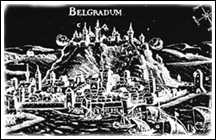 It is believed that the first Serbian (Rascian) coins were issues of St. Sava's elder nephew, king Stefan Radoslav (1227-1234), struck at the capital town of Ras. Few remain today of these coins that closely modeled some earlier Byzantine types (including Greek inscriptions), perhaps reflecting Radoslav's Greek (Dukas family) heritage and aspirations, stemming from his mother's side. However, after his deposition and the destruction of Ras (1233), coins were not struck for several decades.
It is believed that the first Serbian (Rascian) coins were issues of St. Sava's elder nephew, king Stefan Radoslav (1227-1234), struck at the capital town of Ras. Few remain today of these coins that closely modeled some earlier Byzantine types (including Greek inscriptions), perhaps reflecting Radoslav's Greek (Dukas family) heritage and aspirations, stemming from his mother's side. However, after his deposition and the destruction of Ras (1233), coins were not struck for several decades.
Regular issuance of Serbian coins is considered to have started with king Stefan Uros I (1243-1276), probably late in his reign. The silver dinars closely modeled the Venetian grosso - although with the appropriate title and ruler - which eventually led to the monetary embargo imposed by Venice on Serbian coins in 1282. It is not clear today whether this was in response to apparent debasement (lowered silver content) of these coins or for more sinister reasons, but the whole event was noted in Dante's Divine Comedy (with a probable reference to King Milutin):
"And Portugal should be held in blame,
with Norway and the Rascian
who laid his eyes on Venetian coins
and forged his own ill-fame."(Dante Alighieri, Paradise, Canto XIX, Eagle speaking).
The earliest mints in Serbia were around the newly discovered silver mines - the first and largest being Brskovo (Montenegro, since ca. 1270), then Rudnik (Sumadija, since the 1290's), Novo Brdo (Metohija, since 1326), and later several others (Srebrenica, Trepca, Prizren, Ohrid, Plana, Skoplje, Rudiste, etc.).
Republic of Venice, Doge Jacopo Tiepolo (1229-1249)
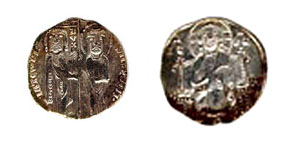
Matapano (Grosso). Obv.: Doge (governor) receiving a banner from St. Mark; Legend: IA TEUPL DUX S.M. VENETI; Rev.: Christ enthroned, holding Book of Gospels, the legend: IC - XC
NUMISMATIC NOTES: Introduced around 1202 (to fund preparations for the grand and infamous Fourth Crusade that eventually sacked Constantinople) by the mighty doge Enrico Dandolo and backed by the Republic's thriving economic power, this coin remained for well over a century the Deutschmark of Southeastern European economy. Although almost all of its design elements are of Byzantine origin - including the iconic image of a facing enthroned Christ with the Greek inscription "IC XC" (for Jesus Christ) on its reverse - their particular combination in this silver coin of stable and strictly controlled weight and purity lasted for over 150 years (with variations in doge only) and became associated strictly with Venice. As such, through imitations and forgeries, it influenced many Eastern Mediterranean coinages, including the first systematic series of Serbian medieval coins.
King Stefan Uros I (1243-1276)
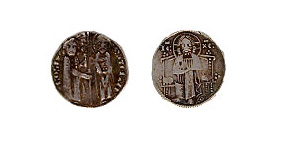
"Banner" dinar. Obv.: Bareheaded King receiving a banner from St. Stephen with his right hand, holding scrolls with his left hand, the legend: UROSIUS REX S STEFAN ("Uros King, St. Stephen"); Rev.: Christ enthroned, holding Book of Gospels, the legend: IC - XC ("Jesus Christ")
HISTORICAL NOTES: The long reign of St. Sava's youngest nephew strengthened the state from the inside. Mine exploitation, money-minting, and commerce bolstered the country's economic base. Religious tolerance ensured firm loyalty of Roman Catholic subjects in the coastal areas. The monastery Sopocani with its frescoes remains one of the gems of medieval European art.
NUMISMATIC NOTES: Early Serbian coinage (to appr. mid-14th c.) features Latin inscriptions, as opposed to the later Cyrillic Serbian ones. One reason is that it was used more for foreign than domestic trade - usually exported by merchants from Dubrovnik to Venice and the West.
Stefan Dragutin (1276-1282)
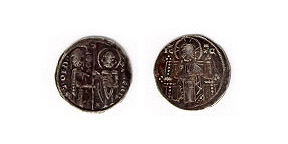
"Banner" dinar. Obv.: King receiving a banner from St. Stephen, the legend: STEFAN REX S STEFAN; Rev.: Christ enthroned, holding Book of Gospels, IC - XC
HISTORICAL NOTES: After the 1282 abdication in favor of his younger brother Milutin, Dragutin remained in charge of Northern Serbia (including Belgrade), and continued to issue money until his death in 1316. The fact that only some of it continued to bear the royal title could be related to the changing relationship between the two brothers.
NUMISMATIC NOTES: The patron saint of the Nemanjic crown, St. Stephen, replaces the Venetian St. Mark on the Serbian dinars.
Stefan Uros II Milutin (1282-1321)
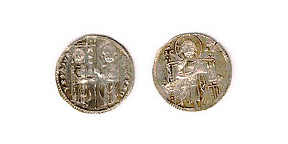
"Banner" dinar. Obv.: King receiving a banner from St. Stephen, the legend: UROSIUS REX S STEFAN; Rev.: Christ enthroned
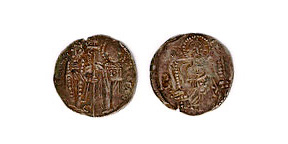
"Cross" dinar. Obv.: King receiving a tall cross from St.Stephen, the legend: UROSIUS REX S STEFAN; Rev.: Christ enthroned
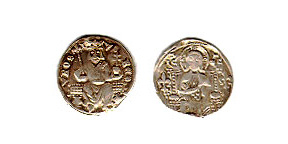
"Lilly and cross" dinar. Obv.: Crowned King enthroned, holding scepter with lily in one hand, and the globe with a cross in the other, legend: UROSIUS REX; Rev.: Christ enthroned
HISTORICAL NOTES: The greatest Serbian statesman between St.Sava and Czar Dusan, Milutin elevated Serbia to a major Balkan power. Many factors contributed to this, including wise exploitation of silver mines (as witnessed by vastly increased coin output). Encouraging arts and letters; built and decorated dozens of churches and monasteries, not only in Serbia (e.g. the famous Gracanica), but also in Jerusalem, Constantinople, and Mt. Athos.
NUMISMATIC NOTES: One of the open issues is that of attributing early dinars. The fact that money was not dated at this time is exacerbated by the proliferation of the royal names Stefan and Uros, and the attributions given here are only probable. The "Lilly and cross" dinar is a radical departure from the earlier Venetian model and is generally considered to be of the finest style for its time.
King Stefan Vladislav II (1321-1324)
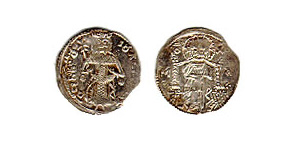
Dinar. Obv.: Vladislav standing, the Cyrillic legend: VLADISLAV RAB HOU; Rev.: Christ enthroned
HISTORICAL NOTES: Dragutin's son Vladislav ruled his father's realm (roughly, today's Srem, Macva, and Sumadija) before a defeat at the hands of Stefan Decanski ended his ambitions in the ongoing dynastic struggle
NUMISMATIC NOTES: The legend used here ("Vladislav, servant of Christ") avoids the use of the royal title, indicating some political compromise on Vladislav's part, despite his claims to the throne.
Stefan Uros III Decanski, King (1321-1331)
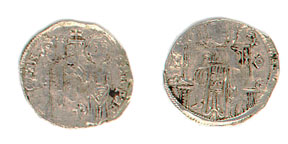
"Cross" dinar. Obv.: Crowned king receiving a patriarchal cross from St. Stephen, the legend: STEFAN REX S STEFAN; Rev.: Christ enthroned
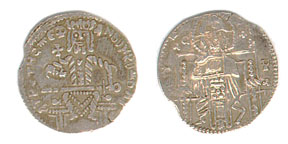
"Sword" dinar. Obv.: Crowned king seated, holding a sword in left, and scepter with a cross in the right hand, the Cyrillic legend: KRA STEFAN OUROS TRETI("King Stefan Uros the Third"); Rev.: Christ enthroned, IC - XC, sigla: B-P
HISTORICAL NOTES: A tragic figure that suffered both from his father and later his son, Stefan nevertheless continued the state's progress. His victory at Velbuzd (1330) effectively reduced the Second Bulgarian Empire to a subordinate state of Serbia; his monastery, Visoki Decani, remains one of the finest medieval Serbian monuments.
NUMISMATIC NOTES: The "sword" dinar is a cornerstone in deciphering some of the attribution mysteries since it is a rare issue that uniquely identifies a Nemanjic dynasty with his full title. The exact meaning of symbols flanking Christ's throne, known as "sigla", is still a mystery - they could be related to mints, mint officials, batches of silver, or engravers.
Stefan Uros IV Dusan (1331-1355)
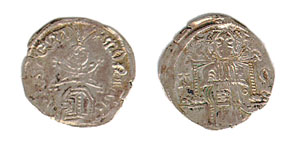
"Helmet dinar". Obv.: Ornamented helmet ("cekrkli celenka"), the legend: MONITA REX STEFA (for "Money of King Stefan"); Rev.: Christ enthroned

"Coronation" dinar. Obv.: Standing Emperor with the sceptre, crowned by two angels, Cyrillic legend: SF ZR ("Stefan Czar"); Rev.: Christ enthroned, IC - XC
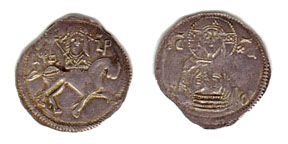
"Horseman" dinar. Obv.: Emperor riding a horse, holding scepter with the cross; Rev.: Bust of Christ blessing, IC - XC, sigla: N-O
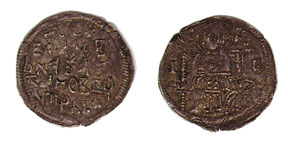
"5-line" dinar. Obv.: Cyrillic legend: STEFAN V HA BA BLAGOVERNII ZR ("Stefan, in Christ our God pious Emperor"); Rev.: Christ
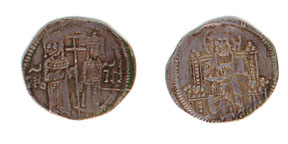
"Two figures" dinar. Obv.: Dusan and Jelena standing, the Cyrillic legend: SF ZR (for "Stefan Czar"); Rev.: Christ
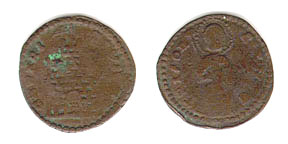
Copper follaro of Kotor. Obv.: St. Triphon, city patron saint; Rev.: City walls, the legend: S TRIFON CATARI
HISTORICAL NOTES: The high point of medieval Serbia, elevating the state into a centralized Empire, and the church into a Patriarchy. Territorial expansion was followed by a unified legal system, defined by the well-known Zakonik, or Legal Code (1349). However, Dusan's ambitious achievements started to unravel after his premature death.
NUMISMATIC NOTES: Medieval coins were hammered between two molds, or dies, one each for obverse and reverse. Dies for most Serbian coin types were engraved ("cut") by a limited number of die-cutters. About 10 such masters have been identified for Dusan's coinage. Incidentally, one die would last roughly 10,000 strikes, and would then have to be redone. Often they would wear unevenly and get replaced at different times, resulting in pairs of coins with only one side from a common die, or even coins with sides from different engravers - all of which are powerful numismatic tools.
Since ancient times and until the advent of mass communication, a coinage by its very nature served as a powerful means for its issuers -, particularly central governments - to disseminate messages, news, and propaganda. Accordingly, the important step of declaring an Empire was accompanied here by new monetary issues, including the original "coronation" design, which simultaneously informed about its occurrence, as well as its divine (and thus indisputable) nature.
Stefan Uros V (1355-1371)
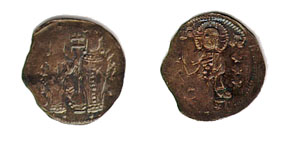
Dinar. Obv.: Imperial couple standing, the Cyrillic legend: OUROS ZR ("Uros Czar"); Rev.: Christ standing
HISTORICAL NOTES: The last ruler of the Nemanjic dynasty, Uros has had a mixed treatment in Serbian tradition. Although considered a feeble ruler unable to hold together the fruit of his father's statesmanship (thus "Uros the Weak"), he has also been seen as a martyr and victim of plots by selfish nobility at the eve of the Turkish onslaught.
Despot Jovan (John) Oliver (1341-1363)
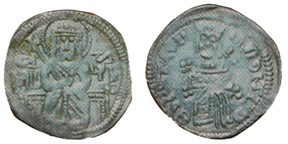
Dinar. Obv.: Emperor Uros enthroned, with the sceptre, the Cyrillic legend: "US ZR ("Uros Czar"); Rev.: Ornamented helmet with nobleman's head on the top, legend: "MONITA DESPOTI IOA".
HISTORICAL NOTES: Throughout Emperor Dusan's rise, Jovan Oliver was one of his right-hand men, whom he elevated upon his imperial coronation to the second-ranking office of the despot. Apart from his military experience, documents show his important diplomatic skills. With his Greek wife and knowledge of the Greek language, he exemplified a newer wave in the medieval Serbian state, where the Byzantine court practices and culture, in general, were being more widely felt.
NUMISMATIC NOTES: Although this issue shows Emperor Uros as the suzerain, similar coins exist with his father Dusan's name. This scarce issue testifies that even during the times of a strong, centralized empire, there was apparently a need for certain regional governors to issue money in their own name (while clearly acknowledging the central state authority) - probably reflecting some peculiar requirements of local circulation.
King Vukasin Mrnjavcevic (1366-1371)
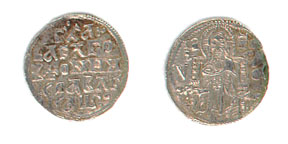
Dinar Obv.: 5-line Cyrillic legend: V HA BA BLAGOVERNII KRA VLKAS ("In Christ our God pious King Vukasin"); Rev.: Christ enthroned
HISTORICAL NOTES: Father of epic folk hero Kraljevic Marko, King Vukasin, just like his son, remains historically rather obscure. Although his murderous plotting against Emperor Uros is probably an invention of 17th c. chroniclers, he contributed to the state's disintegration, and epic tradition didn't treat him kindly. To his credit, together with his brother Despot Ugljesa, he managed to organize a respectable expedition to sack Adrianople and expel Turks from the Balkans once and for all; but their military prowess proved no match for that of their foes, and their death and debacle in the infamous Battle of Marica (southern Thrace) in 1371 opened the door for broader Ottoman conquests in Europe.
NUMISMATIC NOTES: The fact that a junior ruler (king) minted his own money alongside a living emperor attests to the weakening of central rule (although the Byzantine state had survived many such situations). This ushered the proliferation of independent coinages of many petty rulers - a practice to last over three decades until Serbia got reconstituted as a united Despotate in the early 15th c. under Stefan Lazarevic.
King Marko (1371-1395)
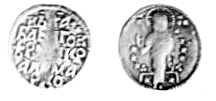
Dinar Obv.: 5-line Cyrillic legend: V HA BA BLAGOVERNII KRAL MARKO ("In Christ our God pious King Marko"); Rev.: Christ standing
HISTORICAL NOTES: The legend of Kraljevic (regal prince) Marko - a witty popular hero, with a keen sense of chivalry and honor, and often superhuman traits, who protects the simple folk from Turkish invaders and other calamities - is among the most popular among the Balkan Christians. It goes well beyond its anchor in Serbian epic poetry, as his deeds are celebrated also in Bulgarian, Croatian, and even Albanian tradition. Historical data on Marko (who ruled in Macedonia as a Turkish vassal after his father's death) is rather scarce, and none of it can clearly justify the myth that has surrounded him. Perhaps it was simply his ability to combine personal honor and courage with an autonomous rule and services to Turkish masters in a way that shielded his subjects from the increased lawlessness of his time and realm. Yet, the moral quandary created by this position took its toll, as contemporary records show him wishing for his own death on the eve of his final battle as a vassal. Poetry expressed this as Marko's lament to his faithful falcon, following a hunting incident with his Turkish masters:
"What burden we bear, good falcon o' mine -
Hunting with Turks, yet none of our kind,
Hunting with them, in evil we share!"
NUMISMATIC NOTES: Marko's money is rare, but constitutes important evidence about a major ruler that has left us surprisingly few real artifacts (e.g., a couple of churches he endowed with some preserved quality frescoes, the walls of his ancient citadel). In particular, valuable implications were made from the titles he used on the coins, and their estimated circulation, mint location, and time (as determined by the group finds, or hoards, that they were part of).
Prince Lazar Hrebeljanovic (1371-1389)
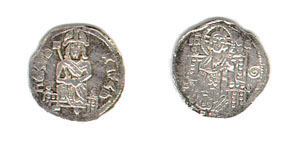
Dinar. Obv.: Lazar crowned and enthroned, holding scepter with the cross, legend: KNEZ LAZR ("Prince Lazar"); Rev.: Christ enthroned
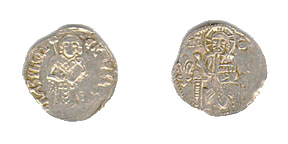
Dinar. Obv.: Lazar standing, holding scepter with the cross, the Cyrillic legend: KNEZ LAZR ("Prince Lazar"); Rev.: Christ enthroned
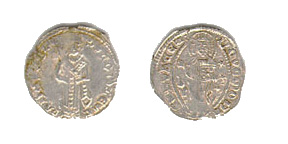
Dinar of Novo Brdo. Obv.: Lazar standing, holding scepter with the cross, legend: CONTE LASARO ("Prince Lazar"); Rev.: Christ standing, the legend: NOVOMONTE ARGEN ("silver of Novo Brdo")
HISTORICAL NOTES: The key figure of Serbian epic tradition, whose choice of "kingdom of Heaven" over "kingdom on Earth" postulates the basic moral tenet that permeated the Serbian national ethic for centuries. A cohesive force in a disintegrating empire, he promoted political unity through both diplomatic and military means and gained ecclesiastic support by helping the reconciliation of Greek and Serbian churches in 1375.
NUMISMATIC NOTES: Historical information can be deduced through numismatic evidence. In the wake of Ottoman advances and dynastic struggles, Lazar appears to have favored unity, first by denying virtually all his vassals minting authority, and second by reducing contention - as evidenced by the gradual elimination of imperial insignia (e.g. closed imperial crown and jewels) from his portrait on coins. The rather quick debasement of his currency also indicates an inflationary economy, probably geared for the final military showdown with the advancing Turks.
Nobleman Vuk Brankovic (1371-1396)
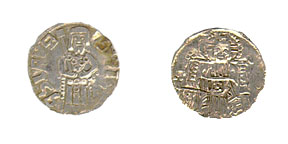
Reduced dinar, Obv.: Vuk standing, holding the banner, the Cyrillic legend: VLK VLK ("Vuk"); Rev.: Christ enthroned
HISTORICAL NOTES: Prince Lazar's powerful vassal and son-in-law, commanded the left flank of the Serbian army during the Battle of Kosovo, which he survived. His Judas-like treachery is one of the cornerstones of the Serbian Kosovo epic. There are several theories why tradition chose him for this infamous role, despite the fact that contemporary chronicles mention no such battlefield treason. Although reduced to a Turkish vassal after the battle, he continued with Hungarophile tendencies, which led to his quick demise following the Ottoman defeat of Hungarian-led crusaders at Nicopolis (1396).
NUMISMATIC NOTES: These coins were probably minted in Prizren just prior to the Battle of Kosovo. The very fact that Vuk is the only nobleman during Lazar's (and his successors') times that put his own portrait - even with some imperial insignia - on coins, partially attests to his ambition and potential disuniting tendency.
Nobleman Jakov (1380's)
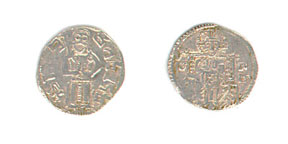
Reduced dinar, Obv.: Vuk standing, holding the banner, the Cyrillic legend: VLK VLK ("Vuk"); Rev.: Christ enthroned, with Cyrillic inscription "IAKV" around
HISTORICAL NOTES: The exact identity of Jakov remains a mystery, although he also minted money with his name only. In general, the question of who had the right to issue money in those times remains an open one, since a number of more powerful contemporary feudal lords apparently minted none.
NUMISMATIC NOTES: The practice of the authority issuing money acknowledging its suzerain is not uncommon at the time, and Vuk Brankovic apparently led a liberal monetary policy, allowing autonomous minting to a number of his petty lords and cities. On the other hand, he himself at some point minted money showing Prince Lazar's suzerainty.
Despot Stefan Lazarevic (1389-1427)
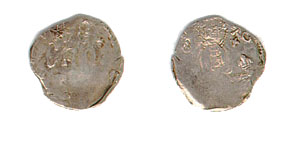
Dinar, Obv.: Cyrillic legend: DESPOT; Rev.: Christ enthroned
HISTORICAL NOTES: A capable and educated ruler, Prince Lazar's elder son was saddled with the task of maintaining the core Serbian statehood in the wake of the Kosovo defeat, and reviving it after Turkey's temporary decline after the Battle of Angora. Belgrade was a flourishing city in his time, and Stefan's walls still form the core of the fortress' Upper City.
Djuradj Brankovic (1427 - 1456)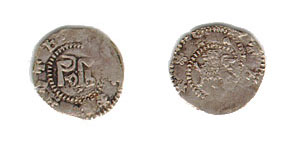
Dinar, Obv.: Cyrillic legend: +GIIN DESPOT surrounding monogram of Djuradj; Rev.: Lion marching
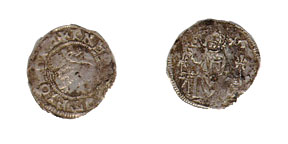
Dinar, Obv.: Lion marching, the Cyrillic legend: +GIIN DESPOT; Rev.: Christ enthroned
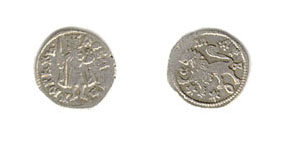
Half-dinar of Smederevo, Obv.: Djuradj standing, holding upright sword and cross; Rev.: Lion, surrounded by Cyrillic inscription SMDRVO
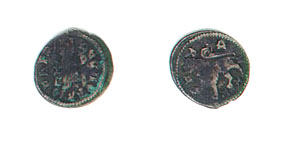
Half-dinar of Rudnik, Obv.: Djuradj enthroned, holding upright sword and cross; Rev.: Lion, surrounded by Cyrillic inscription ROUDNIK
HISTORICAL NOTES: The popular memory of Despot Djuradj - grandson of the famed Prince Lazar - has been partially plagued by association with his father Vuk's ill-fated role in Serbian epics. In fact an able all-around statesman like his uncle and predecessor Stefan Lazarevic (as attested by one of the most beautiful pieces of medieval Serbian literature, the anonymous speech at his funeral), he gave a new lease to life to a truncated Serbian state wedged between Turkey and Hungary, before its inevitable fall. As recently as WW I, the long-abandoned walls of his capital, Smederevo, were meaningfully used against the advancing German armies, and their giant "Fat Berta" cannons.
NUMISMATIC NOTES: Djuradj's coins are generally of high artistic value, like those with a lion, the heraldic symbol of the Brankovic family. While not uncommon in his day, the image of a ruler with a sword in hand particularly befitted Djuradj, who battled valiantly even in his eighties, losing two fingers against Hungarian plotters.
The Coinage of Dubrovnik
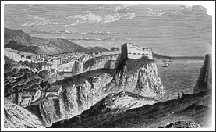 A maritime merchant city-state that emerged from the Byzantine realm, Dubrovnik (Ragusa) became over the centuries a specific cultural combination of old Roman roots, a predominantly South Slavic population, the Catholic religion, and many Serbian traditions and language. During the centuries of Turkish occupation, it remained an important harbor of Serbian literacy, science, and historiography - right until it was extinguished by Napoleon, in 1808.
A maritime merchant city-state that emerged from the Byzantine realm, Dubrovnik (Ragusa) became over the centuries a specific cultural combination of old Roman roots, a predominantly South Slavic population, the Catholic religion, and many Serbian traditions and language. During the centuries of Turkish occupation, it remained an important harbor of Serbian literacy, science, and historiography - right until it was extinguished by Napoleon, in 1808.
With a span of over 500 years, the Dubrovnik coinage series is remarkable, like the Republic itself. Given here is a representative subset of the money that existed in the 15-18th centuries.
Early Dubrovnik

Copper minca (follaro), ca. 1500. Obv.: Renaissance bust of Governor, legend: DUX RAGUSIE; Rev.: City fortress
NUMISMATIC NOTES: Copper coinage (almost entirely absent in Serbia, with the characteristic exception of some coastal cities) was the first to be introduced in Dubrovnik, late in the 13th c., shortly followed by silver money.
HISTORICAL NOTES: The most prominent city wall features shown on the coin - the 14th century City bell tower and Minceta fortress tower - survive as masterpieces until today, despite the earthquake of 1667.
16-17th c. Dubrovnik
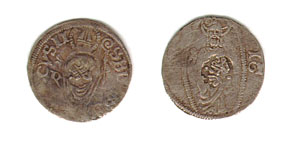
Dinar, mid-16th c. Obv.: St. Blaise, patron saint of the city, the legend: RAGUSE BLASIUS; countermarked with city walls; Rev.: Christ standing; countermarked with St. Blaise's head
HISTORICAL NOTES: The times of the most famous playwriter of Dubrovnik, Marin Drzic. Cyrillic Serbian writing was widely used, even for some Catholic religious texts.
NUMISMATIC NOTES: Countermarks were used as a cheap way of "recycling" money - certified with a stamp that old money is complying with new standards. The one seen here depicts the city protector - St. Blaise (Vlaho), a Greek Christian missionary from Asia Minor that was martyred early in the 4th c.AD.
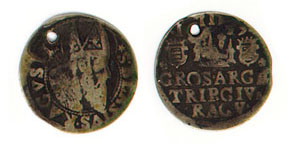
Artiluk (3 dinars), 1635. Obv.: Bust of St. Blaise; Rev.: City view, denomination, coats of arms, legend:GROS.ARG.TRIP.CIVI.RAGU
HISTORICAL NOTES: The early 17th c. in Dubrovnik saw the appearance of Marin Getaldic's mathematical works, Orbini's "Kingdom of the Slavs" - an invaluable account of earlier Serbian history, and Ivan Gundulic's "Osman" - the vernacular Serbian epic that celebrated Christian, Slavic, and Serbian causes in the struggle against the Ottomans.
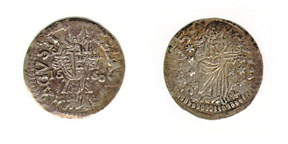
Dinar, 1660. Obv.: St. Blaise, legend: RAGUSE BLASIUS; Rev.: Christ standing, the legend: TVTA SALVS
HISTORICAL NOTES: Seven years later, the Great earthquake will deliver a devastating blow to the City, whose competitive trading advantages had already diminished. By then, Jesuit influences started dominating over old Renessaince ones, as did Latin literature over Serbian.
NUMISMATIC NOTES: During the 17th century, the rendition of St. Blaise's attire changed from the original Greek to a Latin one.
18th c. Dubrovnik
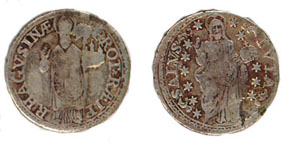
Perpera (12 dinars), early 18th c. Obv.: St. Blaise; Rev.: Christ
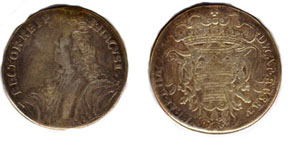
Vizlin (Talir), 1746. Obv.: Baroque bust of Governor; Rev.: Coat of arms of Dubrovnik.
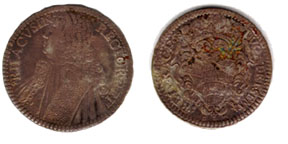
Vizlin, 1768. Obv.: Classicist bust of Governor; Rev.: Coat of arms
HISTORICAL NOTES: Another famous mathematician and astronomer, Rudjer Boskovic, wrote his great works around this time.
Coinage of Serbia and Montenegro (19-20th century)
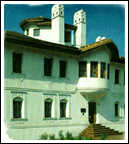 Emerging as independent states in the 19th century, the Serbian principalities (later kingdoms) of Serbia and Montenegro resumed the practice of issuing their own money rather late. Prior to that, monetary deals were typically settled with some combination of Turkish and Austrian currency.
Emerging as independent states in the 19th century, the Serbian principalities (later kingdoms) of Serbia and Montenegro resumed the practice of issuing their own money rather late. Prior to that, monetary deals were typically settled with some combination of Turkish and Austrian currency.
Serbia, whose national liberation started in 1804 and included periods of full independence and varying degrees of autonomy from the Ottomans, started minting coins in 1868. Three small copper denominations (1, 5, 10 paras) were issued in around 7 million pieces each, and these were shortly followed with larger silver and gold coins.
 Tucked in the barren hinterland of the southern Adriatic coast, Montenegro enjoyed a semi-autonomous status within the Ottoman Empire for a long time before securing de-facto independence at the end of the 18th c., but started issuing money only in the early 20th c.
Tucked in the barren hinterland of the southern Adriatic coast, Montenegro enjoyed a semi-autonomous status within the Ottoman Empire for a long time before securing de-facto independence at the end of the 18th c., but started issuing money only in the early 20th c.
One reason for this is the lack of metal, as no mines operated there at the time. (Asked by Rothschild in 1851 why his state doesn't mint money, the famous Montenegrin statesman, poet, and philosopher P.P. Njegos replied: "Sir, if coins were minted in stone, we would've had them long ago...". Ironically, the first silver mine which also spurred coin production in Medieval Serbia was Brskovo, located in northern Montenegro.) Minting commenced in 1906, with four small denomination issues (1-20 para), later to be followed by larger denominations in precious metals.
Prince Mihailo (Michael) Obrenovic III (1860-1868)
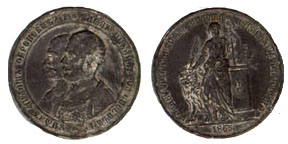
Commemorative medal for the 50th anniversary of the Second Serbian insurrection, 1865. Obv.: Conjoined busts of Princes Mihailo and Milos, Cyrillic legend: KNAZ MILOS OBRENOVIC * KNAZ MIHAIL OBRENOVIC; Rev.: Personification of Liberty with the lion, the Cyrillic legend: U SLAVU USTANKA KNAZA MILOSA 1815. BLAGODARNA SRBIA ("In honor of the uprising of Prince Milos in 1815, a grateful Serbia")
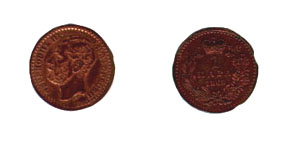
1 para, 1868. Obv.: Prince Mihailo's bust, the Cyrillic legend: OBRENOVIC III KNJAZ SRBSKI ("Obrenovic III, Prince of Serbia"); Rev.: Denominationin wreath
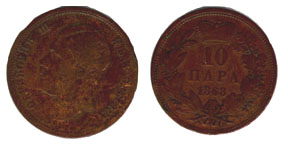
10 para, 1868. Same design as above.
HISTORICAL NOTES: Together with his prime minister Ilija Garasanin, Mihailo started actively promoting the crucial idea of uniting all Serbs in one land. The peaceful expulsion of the last six Turkish garrisons in 1867 meant the final step towards full independence of Serbia, to be ratified by the Berlin Congress in 1878.
NUMISMATIC NOTES: This single-year issue of Prince Mihailo was the first modern Serbian coinage. Only 3 years older, the commemorative medal was minted before Vuk Karadzic's important language reform.
King Milan Obrenovic IV (1868-1889)
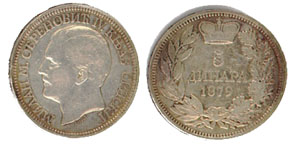
5 Dinars, 1879. Obv.: Milan's bust, the Cyrillic legend: OBRENOVIC IV KNJAZ SRPSKI Rev.: Denomination in wreath
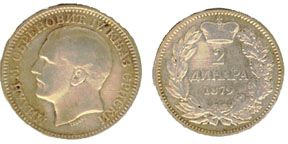
2 Dinars, 1879. Obv.: Milan's bust, the Cyrillic legend: OBRENOVIC IV KNJAZ SRPSKI Rev.: Denomination in wreath
HISTORICAL NOTES: The Eastern Crisis, which started with the Serb uprising against the Turks in Bosnia-Hercegovina (1875), included the Serbo-Turkish war and ended with the Berlin Congress of 1878, taxed the nation heavily but produced rather paltry results, as one of the main aims - the liberation of the Bosnian Serbs - was thwarted by Austrian occupation.
King Aleksandar I Obrenovic (1893-1903)
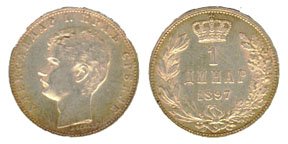
Dinar, 1897. Obv.: ALEKSANDAR I OBRENOVIC KRALJ SRBIJE; Rev.: Denomination in wreath
HISTORICAL NOTES: An ineffective leader, incapable of facing numerous challenges at home and abroad. His assassination in 1903 ended the Obrenovic dynasty.
King Petar I Karadjordjevic (1903-1921)
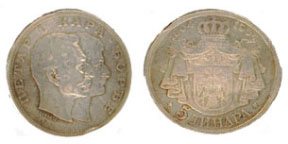
5 dinars, 1904. Obv.: Con joined busts of Petar and his grandfather Karadjordje, the Cyrillic legend: PETAR I KARADJORDJE; Rev.: Serbian coat of arms
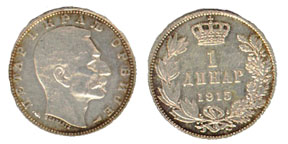
Dinar, 1915. Obv.: PETAR I KRALJ SRBIJE ("Peter I, King of Serbia"); Rev.: Denomination in wreath
HISTORICAL NOTES: This period saw new heights in democratic institutions and economic prosperity, and after the triumphant end to the Balkan and First World Wars, led to Serbia's pinnacle in 1918 - when the new state, Yugoslavia, was built around it.
NUMISMATIC NOTES: The 5 dinar coins commemorates, on its 100th anniversary, the beginning of the First Serbian insurrection against Turkish rule (1804), led by Peter's grandfather Karadjordje - the beginning of modern Serbian statehood.
King Nikola I Petrovic Njegos (1860-1916)
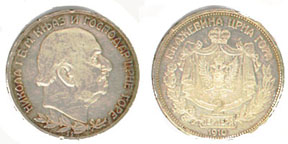
2 Perpers, 1910. Obv.: Bust of Nikola, legend: NIKOLA I B.M. KNJAZ I GOSPODAR CRNE GORE ("Nikola I, by the grace of God Prince and lord of Montenegro"); Rev.: Denomination and Montenegrin coat of arms, the Cyrillic legend: KNJAZEVINA CRNA GORA ("Principality of Montenegro")
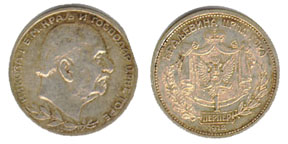
Perper, 1912. Obv.: NIKOLA I B.M. KRALJ I GOSPODAR CRNE GORE; Rev.: Denomination and Montenegrin coat of arms, the Cyrillic legend: KRALJEVINA CRNA GORA ("Kingdom of Montenegro")
HISTORICAL NOTES: The long rule of this statesman and poet, while not without controversies, saw a steady territorial and political growth of the other Serbian state, right until its incorporation into Yugoslavia.
Others
More Information
BLAGO Content
While the content of the BLAGO Fund collections is free to use, there are also some restrictions on commercial use and proper attribution of the material. Follow the links below for more information.
> BLAGO Collections License
> Image Request
BLAGO Fund also accepts the contribution of material. Please contact us with any material you wish to publish on our website.
Contact
BLAGO Fund, Inc.
PO Box 60524
Palo Alto, CA 94306
USA
info@blagofund.org

